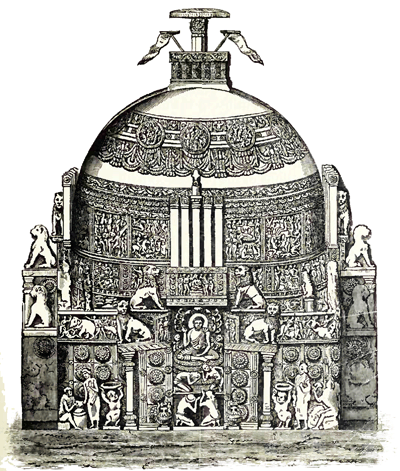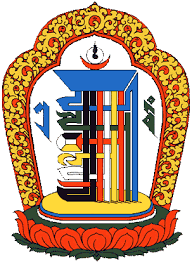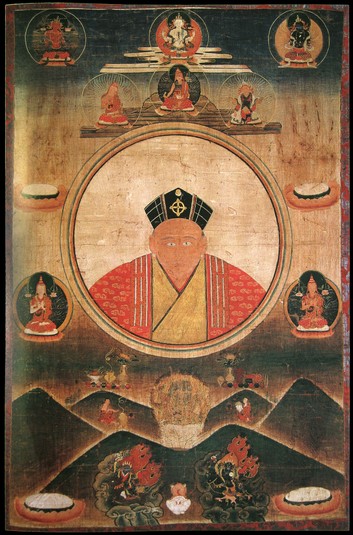
According to the Tibetan Tsurphu calendar, today’s full moon (15th day of 3rd lunar month) is a very auspicious day, as Buddha Amithāba Day, on which the effects of all actions are multiplied 100 times and practice is emphasized. It is also the day on which Buddha Shakyamuni was said to have given the teaching on Kālacakra (Duekhor Duchen) at the great stupa of Dhānyakaṭak (in India).
Here is a small review of the history and origin of Kālacakra in India and Tibet as well as a list of the translations and research I have done on the topic of Kālacakra to date.
Music? Kālacakra mantra OM AH HUM HAM KSHA MALA VARAYA HUM PHET.
The Origin of the Kālacakra teaching: the great stupa of Dhānyakaṭak

According to the Kālacakra tantra, the Buddha taught the first Kālacakra root tantra in Dharanikota (near modern Amaravathi) in 5th century B.C. of southeastern India, supposedly bilocating (appearing in two places at once) at the same time as he was also delivering the Prajñāpāramitā sutras at Vulture’s Peak, in Bihar. Along with King Suchandra, ninety-six minor kings and emissaries from Shambhala were also said to have received the teachings. The Kālacakra thus passed directly to Shambhala, where it was held exclusively for hundreds of years. Later Kings of Shambhala, Mañjushrīkīrti and Pundarika, are said to have condensed and simplified the teachings into the Śri Kālacakra or Laghutantra and its main commentary, the Vimalaprabha, which remain extant today as the heart of the Kālacakra literature.
To describe the history of Kālacakra fully is complex, but all these traditions share a common origin in the early teachings as they emerged in India, apparently from the mysterious land of Shambhala. These traditions were then transfered to Tibet, starting in the early 11th century. All the stories relate that the Buddha taught the Kālacakra Mūlatantra to Sucandra, king of Shambhala, at the great stupa of Dhānyakaṭaka, in Amaravati. These teachings were preserved in that land until approximately the 10th century, when contact between one of Sucandra’s successors and an Indian master (very often named as Cilupa or Piṇḍo Ācārya) saw the adoption of Kālacakra in India.

For more on the history of Kālacakra, see the late Edward Henning’s website here.
The seventeen lineages and Kālacakra in Tibet

The first native Tibetan text on the perfection process meditation of Kālacakra is said to have been written by the Jonang master Kunpangpa (kun spangs pa), who lived from 1243-1313. He collated the different traditions existing in Tibet at the time, and identified 17 distinct traditions of the six yogas. These seventeen Kālacakra lineages in Tibet were reproduced and commented on by the 16th Century Jonang and Shangpa Kagyu master, Jetsun Tāranātha in his Kālacakra masterpiece, Hundred Blazing Lights, for my translation of that section of his text, see here.
As I recently wrote about the Indian siddha, Nāropa is said to have been the actual author of the Kālacakra Tantra text (written down in the 11th Century), according to Indian scholar-translator, Niraj Kumar.

The Tibetan Tsurphu calendar was created and developed by the 3rd Karmapa, Rangjung Dorje (1284-1339), who was the first Tibetan to write in Tibetan about the Kālacakra cosmology and astrological system, in his groundbreaking commentary, see a clip from my brief discussion of that with Niraj Kumar here. For more on the Karmapas and Kālacakra, see here.
The 3rd Karmapa also wrote several commentaries on the Kālacakra sadhana and practice. It is said that when Rangjung Dorje was receiving the Kālacakra initiation, he saw the whole universe placed in a human body. Inspired by this vision he wrote his important treatise on astronomy.
As can be seen from these lineages, the Kālacakra was held by the Nyingma, Karma Kagyu (from the 3rd Karmapa onwards), Jonangpas, and the Sakya. It was only recently in the 19th Century that the practice of mass Kālacakra empowerments was taken to a whole new level by the Gelugpa lineage , first with the 9th Panchen Lama and led by the 14th Dalai Lama, for more on that see here. However, as Niraj Kumar has also pointed out, historically and textually speaking the Gelugpas do not hold any of the seventeen lineages of Kālacakra that came down from India into Tibet, and it is not clear from whom the 14th Dalai Lama got his transmission and empowerment of Kālacakra from either as he has never publicly spoken about his lineage when giving the empowerments.
For more of my original research and translations on Kālacakra and the main Tibetan Buddhist lineages, see below.
Texts and Translations
- Kālacakra Books/Texts
- A Hundred Blazing Lights: Supplementary Commentary on ‘Meaningful to See’ by Jetsun Tāranātha . Translated and edited by Adele Tomlin.
- Meaningful to See: Guidance on the Profound Path of the Vajra-Yogas by Jetsun Tāranātha. Translated and edited by Adele Tomlin (Dakini Publications, 2020)
- Innate Kālacakra: Instruction Texts and Recitations. Translated and edited by Adele Tomlin (Dakini Publications, 2019)
- The Chariot that Transports One to the Four Kāyas by Bamda Gelek Gyatso. Translated and edited by Adele Tomlin (Library of Tibetan Works and Archive, 2018)
Podcast Interview with Kālacakra scholar-translator, Niraj Kumar: (https://www.youtube.com/watch?v=TJ4ec1wV-2o)
Nyingma
The Nyingma Lineage and Kālacakra
JJamyang Khyentse Wangpo, Tāranātha and Nyingma lineage texts on Kālacakra
Karma Kagyu
The ‘nature’ and ‘meaning’ of mantra, tantra and the ten-syllables in Kālacakra by Jamgon Kongtrul
Kālacakra and the 3rd Jamgon Kongtrul: record of an empowerment and teaching
HE 12th Gyaltsab Rinpoche: ‘Liberating All by Knowing One’ and Kalacakra
Part I: The Dagpo Kagyu lineage holders of Dro/Jonang Kālacakra
Part Two: Kagyu masters of the Jamgon Kongtrul lineage of Dro/Jonang Kālacakra
The Karma Kagyu and Kālacakra: ‘forgotten lineages and texts’: Tsami and Rechungpa
Karma Kagyu Kālacakra Masters and the Bokar Rinpoche Kālacakra Stupa
Jonang
Ultimate ‘ecstatic union’ the meaning and role of ‘erotic bliss’ in tantra and Kālacakra
Machig Jobum: Female mahasiddha and lineage holder of Dro Kālacakra
”Love is the water of compassion’ Tāranātha on the four immeasurables in A Hundred Blazing Lights
The meaning of ‘innate’ (lhan skyes) in generation stage Kālacakra
The Seventeen Lineages of the Kālacakra Six Vajra-Yogas
Sakya
Gelugpa


Always floored by your output! The energy, commitment to the Dharma… May all beings benefit from your activity!
Kind regards, Gordon
On Tue, Apr 23, 2024 at 2:42 AM Dakini Translations and Publications
Thank you Gordon! I will add your lovely quote to my article and personal website, at https://adeletomlin.com